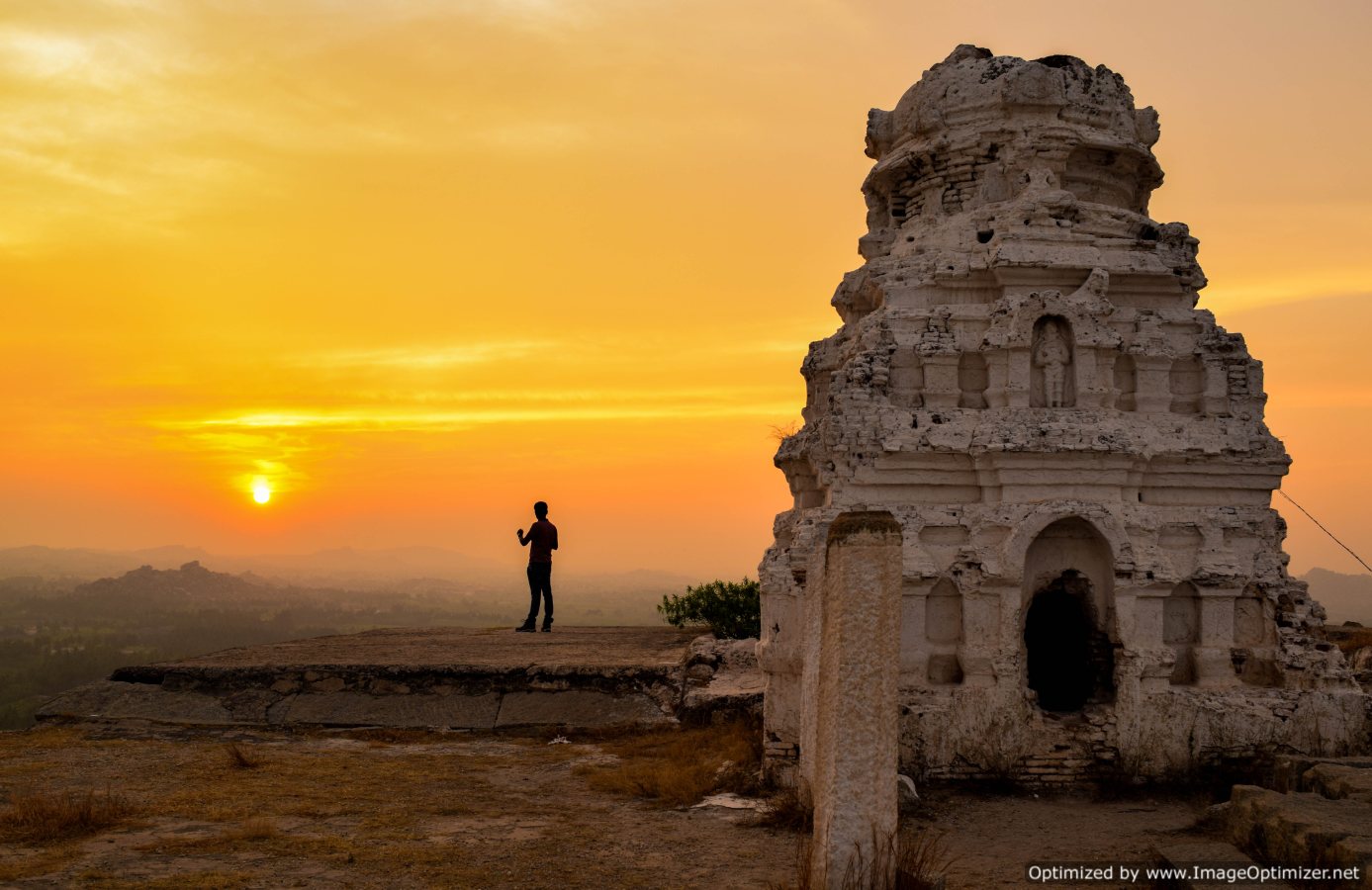
Be at Hampi for these coloured evenings
There are two sides of Hampi. One for the new age carefree tourists seeking tranquillity, crammed in a side which is strangely defended, where new world sets in, of open roof restaurants, budget hotels, funny fags and smokey sticks. Initiate a conversation with anyone there and a quaint picture of Hampi is portrayed, one that of a laidback and soothing town, away from urbane madness, a place no short of novel experiences, of endless trekking, night-outs on boulders, scooter renting and biking on sun-baked roads leading from nowhere to nowhere, boulder rappelling and almost everything you ever had noted in your list of ‘to-do once in life’. A new age hippie backpacker’s paradise, Hampi lives upto your expectations.
And then there is this second side, which lives in its own mystic, narrating the confusing stories, telling tales of things forgotten and no more itched in most history books. I was on the other side; the side of stories, forgotten past, temple ruins standing as gruesome reminders of history and mythology; the side marked with charming eccentricity.
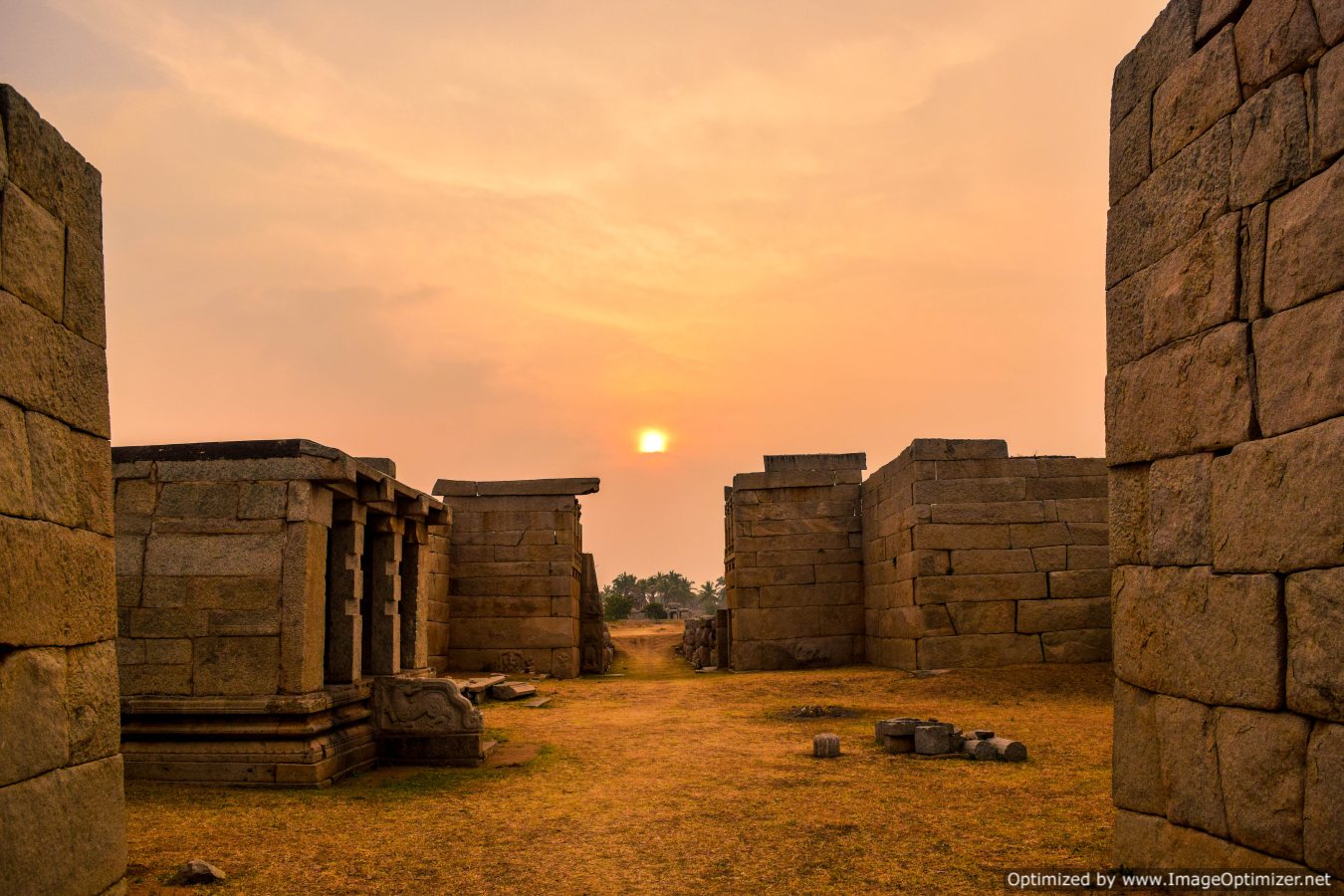
Gates to the forgotten Vijayanagar empire
Sitting upon the Mathunga hill on a large expanse of flat rock, I looked down on Hampi. A splendid view of ochre coloured boulders, the mighty Tungabhadra snaking its way through them, life living its course on coracles as they sailed from one end of the river to the other, oases of green palms and plantations on the sides, little lost temples clinging to the hillside and the mystique and splendor of the impressive Virupaksha temple piercing the azure blue sky. The boulders are enormous, mysteriously held in their respective position, defying gravity as if some magical spell has kept them from falling. They stretch for miles and hold many secrets of the great empire of Vijayanagar that flourished here. Everything seems frozen, the history, the mystique, the culture that refused to die, the carvings that lived all war, the hundreds of temples nestling themselves away from prying eyes and also the people, who came here as tourists and merged with the silence of the place.

Virupaksha temple from Hemkunta hill
They say Hampi is like an unfulfilled dream; serene, splendid and some laid back, where you can lounge about restaurants overlooking the river, where marijuana is in abundance, and where you can be yourself for days, weeks or even months.

The king’s platform in Hampi’s royal enclosures
We trekked down to the Achyutaraya Temple and wandered silently among the ruins. It’s a place to sit, contemplate, think and reflect on whatever you want to. Only a handful of tourists venture here and those who do chose not to spend a lot of time. Take moments to get an eyeful of the crumbling walls, walk down the old Bazaar outside the temple, it conjures up images of the forlorn era, when merchants would shout their wares from the stalls. Now it’s deserted, but never fails to invoke images of those long gone days. But during its heyday in the 1400s, Abdur Razzak, a Persian ambassador to the kingdom, wrote: “Each class of men belonging to each profession has shops contiguous the one to the other; the jewelers sell publicly in the bazaars pearls, rubies, emeralds, and diamonds.”

Remains of the King’s palace
As I walked, I grew more knowledgeable of the intricate religious and historical sides of Hampi. From a distance, the behemoth red granite boulders, shadowing the town, looked like an overgrown childhood collection of marbles. It had gone dark and we tried to take in as much as visual treat as we could, dodging spiky cacti, and unscathed of the numerous stories of bear and leopard, my guide Rajesh had laden me with. A small flame flickered inside a temple, sandwiched between the large boulders, one of the many temples strewn around. This one showed signs of life and our only source as we walked along the Tungabhadra River, spell bound by the majestic silhouette of boulders and derelict structures on them, as they shone in full moon light.
I broke for the day, but Hampi still hung on me. I lived the munificence of the Vijaynagar kingdom every minute, in the award winning design of the Orange County Resort.

The elephant stables at royal enclosure. Notice the Indo-Islamic design in domes and arches.

The lotus Mahal, another piece of Indo-Islamic fusion with feminine arches and lotus marked crown
The next day we set off for the royal enclosures, walking among the ramparts of what once used to be the fort walls, halls and irrigation channels, under the baking sun. A maze of platforms, little passes, hidden chambers, broken pedestals, water channels leading to step-well and ruins that could have once been a temple; everything takes you back ages. My guide Rajesh pointed at another set of ruins that was once the mighty ruler Krishna Deva Rai’s palace. “What triggered Hampi’s destruction?” I asked.
“The Bahamani kingdom, which included sultanate of Bidar, Birar, Raichur, Gulbarga and Golkonda came together and attacked Hampi. After defeating Hampi, when they didn’t find much treasure, they burned the entire city down” he answered.
I strode towards the Queen’s bath, an immaculate, now empty pool where the royal ladies once used to bath. There was a deep trench ringing the building. “The king filled it with crocodiles so that no one could watch the queen in her bath” explained Rajesh. Ah! so no peeping inside.

Queen’s royal bath, the buildings with a touch of Islamic designs are more intact, probably for the same reason
A little further are more intact buildings, the lotus palace, the royal stable and guards place, buildings with conspicuous eclectic mix of Indo-Islamic design in their architecture and probably the most plausible reason for these buildings to be spared the destruction. We strayed further to more ruins, along an out of the way path, to take rest under one of those impossibly balanced rocks, which in the real world shouldn’t have been standing, but then this was Hampi, a chapter taken out of a fancy tale. The wind roared again. I have seen many desolate places, but there is a certain peculiarity here, an unparalleled charm, something that grows and stays inside you. It was my second time to Hampi, but I still feel unsatiated, I feel some corners are still to be discovered, the grandeur requires some more eyeing.
The four O’ clock sun had started to shade the landscape redder, the wind blew hard as it swept the barren landscape, shadows were thrown longer. We made our way to the Vitthala Viman temple. The Sun chariot in the center, stood as indication of the flourishing past, this city had seen. The ornate pillars of the Kalyan mandap, had scriptures of a mythological animal Yali, with a body of a horse, head of a lion with a trunk of an elephant indicating qualities of agility, responsiveness, power and geniality as leadership traits that every ruler should have. The outer walls have eloquent carvings of Hindu spiritual tales, King’s administrative systems, social orders and carvings depicting Hindu beliefs and philosophy, indicating that temple in those days doubled up as a center of social learning. Frankly I was taken in by the Sun chariot in the temple. Looking at it and the grand spectacle that was before me, words of Nicole Conti, the first European to see the Vijayanagara Empire when he arrived in 1420, rung in my ears “I never saw a place like this”. I wondered where was Hampi in my history books, for which British Historian Robert Swell wrote in his book Hampi: the forgotten empire “a city with which for richness and magnificence no known western capital could compare;”. I read Alexander, Marathas, Guptas, Cholas but was the Vijaynagar empire missed. I could recollect a slight mention of Krishna Deva Raya, but looking at this marvel, I knew I hadn’t read enough. This discovery was both humbling and exhilarating. One look spared at the bazaar, a common thing outside any temple, and we moved on. As my guide told, temples were the centers of the city and it was usual to have market place around temples. Thus, the city was broadly divided into a royal complex, the sacred or market complex and the residential complex which housed the citizens.

Vitthala Viman Temple – British Historian Robert Swell wrote in his book Hampi: the forgotten empire “a city with which for richness and magnificence no known western capital could compare;”

I was completely taken in by the Sun Chariot in the Vitthala Viman Temple
The story of Hampi is fascinating. Harihara Raya, in 1336, decided to make this place his capital when he saw a wild hare chasing away his hunting dog. He was so amazed with the ferocity of this soil that produced a hare which could quiver his dog into submission that he decided to build his empire here. For almost 200 years Hampi continued to grow, attracting trade from all across the globe. Krishna Deva Raya’s reign was the Golden period for Hampi, when it prospered and grew into a powerful empire mustering million-man armies, and housing 500,000 people, second only to Beijing then. Trade relations were established with traders from far-off Portugal, Russia and Italy, as well as Mongols, Persians and Arabs. The pillars on the monolithic Ganesh temple, prove a great learning point for trade related aspects of the empire. The wealth of the empire invited enemies and in 1565 an alliance of Muslim invaders known as the Deccan Sultans laid waste to the empire. The city was destroyed, citizens slaughtered, temples razed, monuments trounced; all for whole five months. Swell writes “Never perhaps in the history of the world has such havoc been wrought, and wrought so suddenly, on so splendid a city.” But even all this carnage couldn’t erase the grandeur of Hampi. It still lives in its scattered empty monuments.

With its randomness Hampi is an incredible place for photography

Some more randomness thrown in – five Shiva lingas denote five elements of nature
Hampi draws you. Every corner is full of stories. I learnt as I moved, the interlocks in the pillars of the temples, the marks in the large granite pieces where wood was fixed and then watered and expansion of the moist wood resulted in mechanical weathering of granite which were later shaped, the three shiv-lingas on rocks indicating the three power centers of Hindu philosophy and the five shiv-lingas, indicating the five elements, the small temples built by traders, the numerous pillars as we reached the Virupaksha temple, everything had a tale to learn from. From a distance, Virupaksha temple, looked like some lost Mayan or Egyptian wonder, pyramidal cone with intricate carvings, open sanctorum area, frescos and ornate pillars; an absolute wonder. And right outside the temple is its living treasure, Lakshmi, the town’s holy elephant, who taps a blessing on your head, once offered a coin. I stood in delighted awe as I glanced on the intricate work on the pillars and the roof in the temple. Rajesh told me the meaning of each painting on the roof, some pertaining to social order and some to religion. I listened patiently.
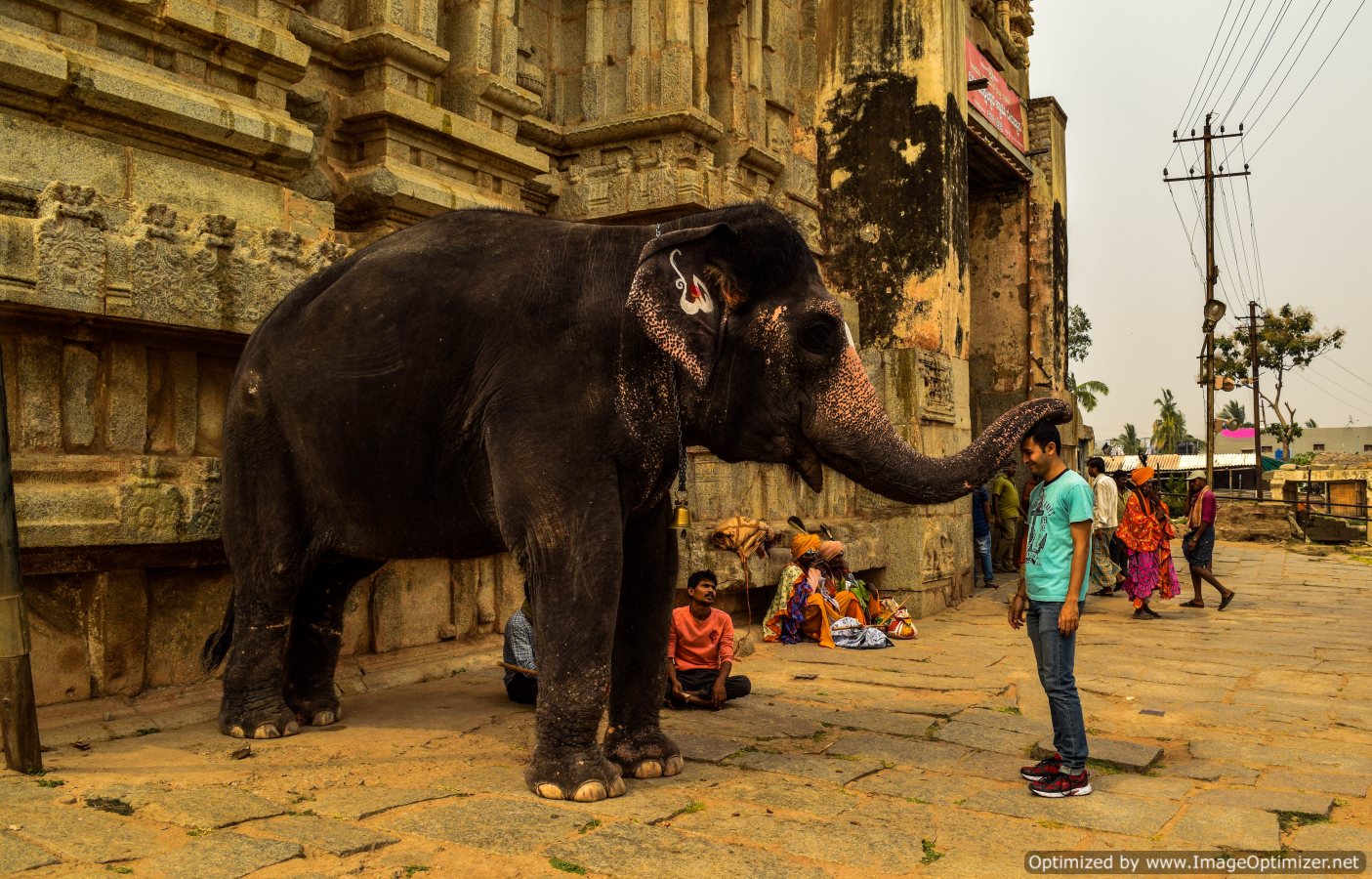
Getting blessed by Laxmi, at Virupaksha Temple

The interiors of Virupaksha temple
Hundreds of years have passed and the ruins can still take you back to that forgone era, as if everything is alive. It’s a feeling that nothing has changed, just frozen, wrapped in time in the nursery of nature. It’s like all the fighting stopped yesterday. As you wander through the royal enclosures, you get the feeling that all the art, the smell of Vijayanagar cuisine, the rhythm in orchestrated steps of the courtesans, the clink of coins, the subtle fragrance of sandalwood in the air, rustle of silk, the beating of drums as Krishna Deva Raya enters his palace, the festivity of the bazaars, grandeur of the hundreds of temples which lie wasted today, the tap of horses’ steps, elephants trumpets in the stable, the playful laps in the bigger than Olympic sized pools, the giggles of royal ladies as they play – are all hidden beneath the surface, ready to sprint back to life, if you wish to read it. This is the grand stage of Hampi – immortal.
- Yali – a mythical creature with a lion head, body of a horse and a trunk
- Monolithic Ganesha
(Hampi has a huge connection with the Hindu epic ‘Ramayana’. According to Ramayana, this place was Kishkingdha, the birthplace of monkey God Hanuman. Even the Matunga hill has its story. Legends say that once an ascetic Matunga was meditating in the hills when Bali (King of Kishkingdha) came to the hill looking for a demon. This angered the ascetic and he condemned him that he would die if he ever stepped on the hill again. When the two brothers, Sugriva and Bali fell off each other, Sugriva took refuge in the Matunga hill to keep himself safe from Bali. Lord Ram met the monkey king and his army in the Matunga hills.)
To go – Hampi is in North Karnataka, 6-7 hours journey from both Bangalore and Hyderabad. The nearest railway and bus station is Hospet (10 kms from Hampi).
To stay – For budget travelers, scores of stays available. For Luxury seeking travelers, visit Orange County resorts.

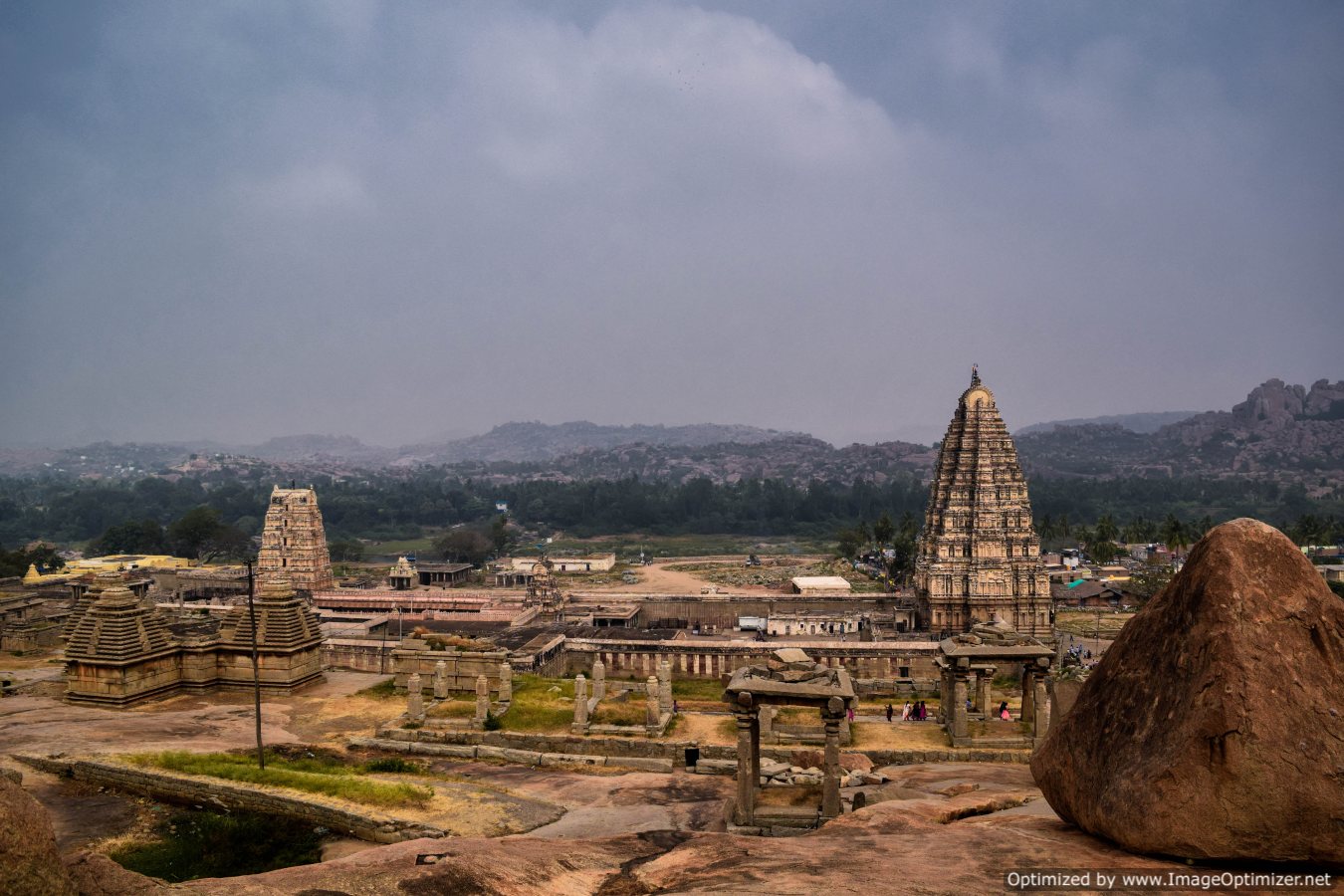
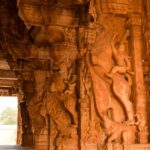
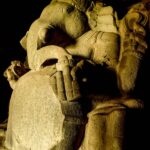


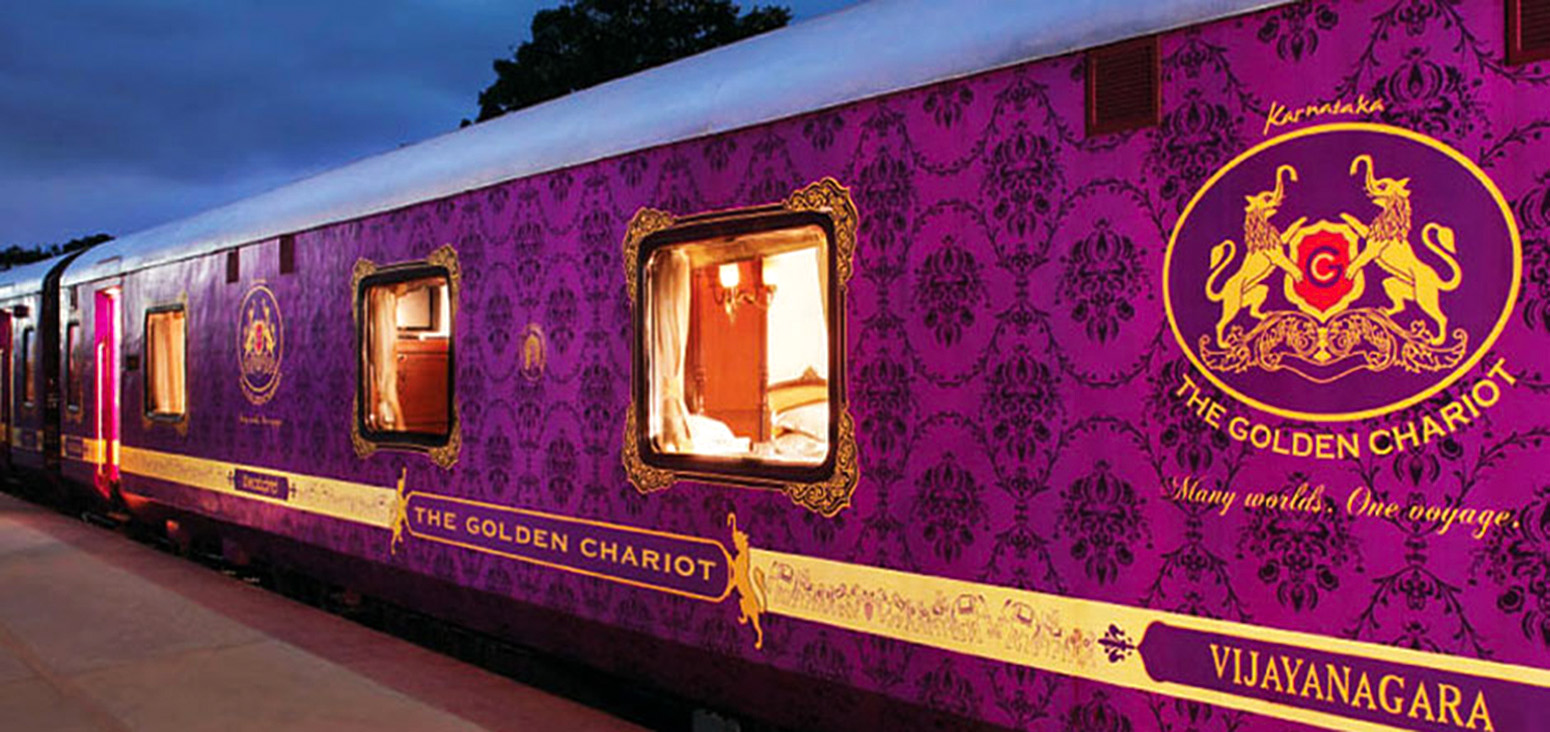



[…] my story on Hampi to acquaint yourself more with the […]
[…] Belur and Hallebid in Hassan, we moved to the deeply romantic remains of the Vijaynagar empire in Hampi, a UNESCO world heritage site, running for over 10 square miles and then to the rock temples of […]
Cool. I spent a long time looking for relevant content and found that your article gave me new ideas, which is very helpful for my research. I think my thesis can be completed more smoothly. Thank you.